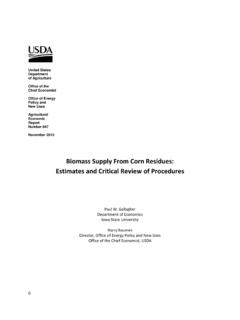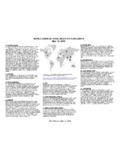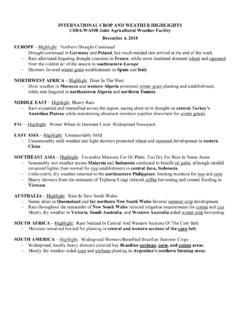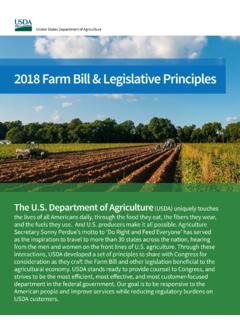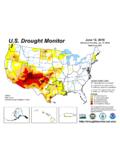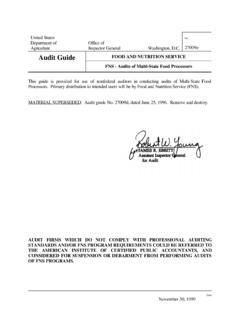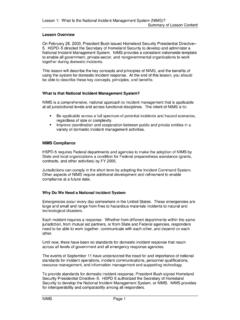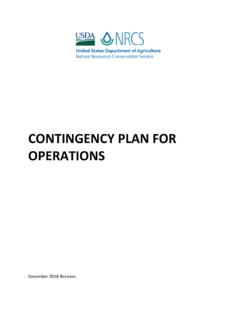Transcription of World Agricultural Supply and Demand Estimates - …
1 World Agricultural Supply ISSN: 1554-9089. and Demand Estimates Office of the Agricultural Marketing Service Economic Research Service Chief Economist Farm Service Agency Foreign Agricultural Service WASDE - 574 Approved by the World Agricultural Outlook Board February 8, 2018. WHEAT: Projected 2017/18 ending stocks are raised this month by 20 million bushels as higher food use is more than offset by lower exports, while export forecasts for several major competitors are increased. Estimated food use is increased by 5 million bushels to 955 million, based on the NASS Flour Milling Products report, which indicated higher-than-expected use in the first half of 2017/18. Additionally, implied flour extraction rates were lower in the second quarter, as compared to last year, and a continuation of this trend is expected to support increased wheat for food usage into the second half of 2017/18.
2 No other Supply or use categories are changed this month. Based on NASS. prices reported to date and price expectations for the rest of the marketing year, the projected season-average farm price (SAFP) remains unchanged at the midpoint of $ per bushel. However, the projected SAFP range is narrowed by 5 cents at both ends of the range to $ to $ Global 2017/18 wheat supplies increased, primarily on higher production forecasts for Argentina and Ukraine. Argentina's wheat production increased by 500,000 tons to million based on higher-than-expected yields from the later harvest stages. Ukraine wheat production increased 481,000 tons to million based on updated government data. World 2017/18 trade is raised this month as higher exports from Russia, Argentina, and Canada more than offset reduced exports from the EU and the United States.
3 Projected imports are increased for Indonesia and several African countries while reduced for India, the EU, Iran, Brazil, and Mexico. Indonesia's imports are raised million tons to million on increases for both food and feed use. Indonesia is now the leading global wheat importer, surpassing Egypt, the traditional leader. Total World consumption is projected million tons higher, primarily on greater usage from Indonesia and China. Projected global ending stocks are million tons lower this month at million but remain significantly higher than a year ago. COARSE GRAINS: This month's 2017/18 corn outlook is for increased exports and reduced stocks. Exports are raised 125 million bushels, reflecting price competitiveness and reduced exports for Argentina and Ukraine.
4 With no other use changes, corn ending stocks are lowered 125 million bushels from last month. The season-average corn price received by producers is projected at $ per bushel, up 5. cents at the midpoint. The sorghum Supply , use, and midpoint price forecasts are unchanged relative to last month. WASDE-574-2. Global coarse grain production for 2017/18 is projected million tons lower to 1, million. This month's foreign coarse grain outlook is for lower production, greater consumption, and lower stocks relative to last month. Global corn production is lowered million tons largely reflecting reductions for Argentina and Ukraine. For Argentina, persistent heat and dryness during January and early February reduced yield prospects for early-planted corn in key central growing areas.
5 Production is lowered for Ukraine based on the latest official statistics. Small increases for Moldova, Mexico, Bangladesh, and Thailand are partly offsetting. Barley production is raised for Argentina. Mexico sorghum production is increased. Major global trade changes for 2017/18 include higher projected corn exports for the United States and Brazil, with reductions for Argentina and Ukraine. Corn imports are raised for Turkey, the EU, and Brazil. Foreign corn ending stocks are down from last month, mostly reflecting reductions for Argentina and Ukraine that more than offset increases for Mexico, Brazil, and Turkey. Global corn ending stocks, at million tons, are down million from last month. RICE: The 2017/18 rice Supply and Demand Estimates are unchanged this month.
6 The projected season-average farm price for all rice is lowered 10 cents at the midpoint of the range. The reduction is primarily attributed to lower-than-expected long-grain prices reported by NASS. Global 2017/18 rice supplies are lowered million tons on reduced beginning stocks and lower production. Total World production is only down fractionally primarily on a smaller Bangladesh crop. Exports are up million tons to a record million. Export changes are led by a increase for India and a increase for Burma. Imports are raised million tons for Bangladesh and million for Indonesia. Total global use is raised million tons for 2016/17 but reduced million for 2017/18. For the 2017/18 marketing year, consumption is lowered million tons each for Bangladesh, Burma, and India, while it is raised million for China.
7 Ending stocks are down million tons but remain the highest since 2000/01. OILSEEDS: This month's 2017/18 soybean outlook is for reduced exports and increased ending stocks. soybean exports for 2017/18 are projected at 2,100 million bushels, down 60 million from last month, reflecting shipments and sales through January and increased export competition on larger supplies in Brazil. With soybean crush unchanged, soybean ending stocks are raised 60 million bushels to 530 million. The season-average soybean price range for 2017/18 is projected at $ to $ per bushel, unchanged at the midpoint. soybean oil prices are forecast at 31 to 34 cents per pound, down 1 cent at the midpoint. soybean meal prices are projected at $305 to $335 per short ton, up $5 at the midpoint.
8 Global oilseed production for 2017/18 is projected at million tons, down million with lower soybean production partly offset by higher cottonseed. soybean production is reduced million tons to million. soybean production for Brazil is projected at million tons, up million, as favorable weather throughout the growing season WASDE-574-3. has raised yield prospects. Argentina production is reduced million tons to million on lower harvested area and reduced yields resulting from periods of unseasonable warmth and dryness. soybean production is also reduced for several other countries including Paraguay, Bolivia, India, Ukraine, and South Africa. Other changes include reduced sunflowerseed production for South Africa, increased cottonseed production for China, and lower cottonseed production for India.
9 Global oilseed crush for 2017/18 is projected at million tons, down million. Reduced soybean crush for Argentina and India accounts for most of the change. Global oilseed stocks are projected lower with reduced soybean stocks for Argentina, Bolivia, Paraguay, and India more than offsetting an increase for the United States. SUGAR: Total sugar Supply for 2017/18 is decreased by 57,469 short tons, raw value (STRV). Cane sugar production for 2017/18 is reduced 44,356 STRV to million. Based on industry reporting, processing in Louisiana continued later than usual into late January, and production for the crop year totaled million STRV, up 38,644 from last month. This gain is more than offset by a processor-forecast reduction in Florida cane sugar production of 83,000 STRV.
10 Beet sugar production is reduced by 37,800 STRV to million. Although the sucrose recovery from sliced sugarbeets in December, as reported in Sweetener Market Data (SMD), is down significantly from the previous month, most of the reduction is expected to be made up based on processor-sourced information. Increased beginning stocks of 24,687 STRV offset some of the reduced production, as 2016/17 imported sugar originally recorded as a direct consumption import was revised in SMD as raw sugar imported by a refiner. Deliveries for human consumption for 2017/18 are reduced by 75,000 STRV to million, based on a slower than expected pace in the fourth quarter of 2017. The residually determined change in projected ending stocks for 2017/18 is million STRV, up 17,531.
